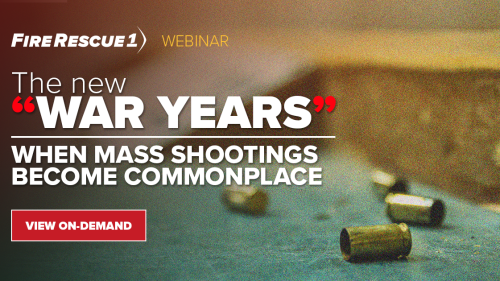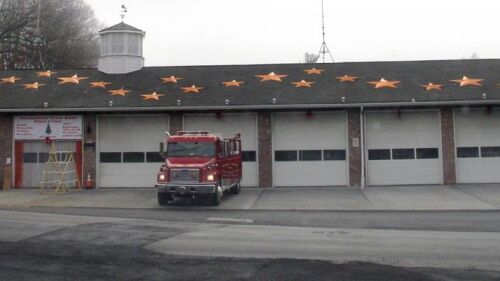On April 20, 1999, the Columbine High School shooting occurred, leaving 12 students and one teacher killed and 24 others wounded. There were two shooters with self-inflicted fatal wounds within 45 minutes from start of incident, but there was no significant law enforcement entry for over an hour and no medical operations for four hours.
After this incident occurred, the law enforcement community experienced a paradigm shift and adjusted their procedures/tactics to quickly enter an area where shooters are suspected to be and make contact with the shooters. However, the Columbine incident had little to no change in the way fire departments or EMS responded into an active shooter/hostile event (ASHE) incident. Fire rescue and EMS assets continued to stage until law enforcement determined the scene is secure (location determined to have no continuing threat and is controlled by law enforcement), which can last hours. As a result, there was a significant delay in medical operations and the wounded continued to die.
In April 2013, four months after the Sandy Hook Elementary School shooting that killed 20 children and six adults, members of multiple agencies – the IAFC, International Association of Chiefs of Police (IACP), FBI, American College of Surgeons, DHS and many other organizations –formed a committee. The committee’s goal was to create a national policy to enhance survivability from intentional mass casualty and active shooter events. The committee’s recommendations are called the Hartford Consensus. The Hartford Consensus concluded that “integrated and coordinated planning, policies, training, and team-building prior to any incident will ensure effective and successful response.”
Over the next three years, the Hartford Consensus developed four additional reports:
- Improving Survival from Active Shooter Events
- Active Shooter and Intentional Mass Casualty Events
- Implementation of Bleeding Control
- A Call for Increased National Resilience
Across the country, we started to see fire departments and EMS agencies begin to train with law enforcement for an integrated response. Fire, EMS and law enforcement thus began working together to save lives in an ASHE in the warm zone, but there still was no consensus standard in place.
On June 12, 2016, the Pulse Orlando nightclub left 49 people killed and 53 more wounded. After that incident, the NFPA was requested to develop a standard multidisciplinary program for preparedness, response and recovery to ASHE, with 53 members appointed to the committee from a wide range of expertise. The standard was developed and, in 2018, NFPA 3000: Active Shooter/Hostile Event Response (ASHER) Program was released.
NFPA 3000 2021 Edition was approved as an American National Standard on April 4, 2020.
Understanding NFPA 3000
The primary objective for NFPA 3000: Standard for an Active Shooter/Hostile Event Response (ASHE) Program is to provide a single set of requirements to be used by the entire community in the event of an active shooter MCI. These requirements address unified command, integrated response and planned recovery as they relate to the overall effort, including the community as a whole.
Let’s look at each component:
- Whole community: Providing training and education to community members, preparedness information, bleeding control and emergency action plans for facilities.
- Unified Command: When and why a Unified Command needs to be in place, practiced and institutionalized by the Authority Having Jurisdiction (AHJ).
- Integrated response: All public safety agencies that may be involved in a response collaborating to develop common operational plans in order to function as a cohesive, integrated unit.
- Planned recovery: Planning for each of the Recovery Phases (immediate, early and continued recovery) is essential.
Let’s take a deeper dive into Unified Command and its common terminology, providing recommendations for best practices.
Unified Command basics
Establishment of a Unified Command is paramount for an effective, organized response to any type of MCI or ASHE.
As defined by FEMA, Unified Command is a structure that allows for multiple jurisdictions, a single jurisdiction with multiagency involvement, or multiple jurisdictions with multiagency involvement to manage an incident. Unified Command allows agencies with different legal, geographic and functional authorities and responsibilities to work together effectively without affecting individual agency authority, responsibility or accountability.
If we review the after-action reviews (AARs) of several recent ASHE incidents, the consistent item that appears was the failure to establish a Unified Command and/or co-locating all agencies with a responsibility in the incident at a common Command Post (CP). The lack of a Unified Command can greatly hamper the communications between disciplines and jurisdictions.
In addition to real-life MCI/ASHE incidents, I have participated in hundreds of MCI/ASHE-type full-scale exercises where the fire/EMS incident commander requests a law enforcement representative to report to their Command Post; however, law enforcement takes no action, instead remaining in their separate command structure. I strongly encourage you to take an active approach to this and establish before an incident occurs an agreed upon process to either co-locate fire/EMS and law enforcement in the Command Post or establish a Unified Command comprised of all responsible disciplines.
A Unified Command (consisting of fire/EMS and law enforcement, at a minimum) is the most appropriate course of action during an ASHE. The use of common terminology or “plain text” communications and a Unified Command, as advocated under the National Incident Management System’s (NIMS) Incident Command System (ICS), creates a more streamlined response that will increase responder safety, allow for quicker access to injured victims, and ultimately increase victim survivability. Incident Action Plan development should include input from fire/EMS and law enforcement to ensure objectives are both attainable and within the scope of each agency’s job function.
Common terminology can be a challenge, as fire/EMS agencies sometimes use different terminology, abbreviations and acronyms than law enforcement, and we need to know each other’s language. Fire/EMS typically uses plain text while law enforcement uses 9 or 10 codes. Another big challenge is that fire/ EMS use letters to designate each side of a building, moving clockwise starting at the front of the building, which is side A, whereas law enforcement typically uses numbers to designate each side of a building, moving counterclockwise.
As you can see, this can create much confusion. Additionally, fire/EMS agencies typically identify building floors by number (i.e., “Floor #1, 2, 3”, etc.), whereas some law enforcement agencies use letters (i.e., “Floor A, B, C”).
One last communication challenge is ensuring that fire/EMS personnel understand common law enforcement terminology, such as such as “Cleared,” “Secured,” “Cover” and “Concealment.”
These differences are significant and will lead to confusion and perhaps worse, like someone operating in a hazardous area. There is no clear-cut answer to the difference in terminology. I recommend having planning meetings with the responses agencies and discuss the terminology prior to any event. It is imperative that responding agencies work through these differences before an actual incident occurs and practice their use in training.
Final thoughts
Fire/EMS and law enforcement agencies will not be able to predict nor stop every ASHE; however, they can increase the survivability of the victims and ensure the safety of the responders using standard operating procedures, establishing Unified Command, understanding common terminology, and holding joint training and exercises. Regardless of your discipline, our objectives are the same: “Stop the killing, stop the bleeding and stop the dying.”
Stay safe.



















